By Dave McCracken
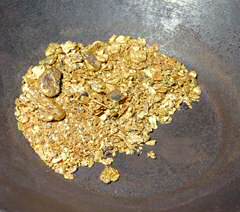
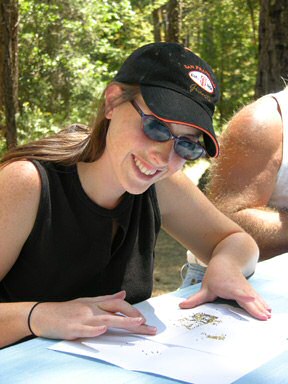
were nuggets. Lilly Fuller smiles as she cleans up the final concentrates for the week.
This Group Project took place on the Schutts Gulch claim along the Klamath River at K-11, several miles upstream from Seiad Valley, about 20 miles upriver from Happy Camp. There were 14 participants (11 men and 3 woman), including myself and my 3 experienced helpers, Craig Colt, Ernie Kroo and Dale Carnagy. Several of the participants were dredging for the first time ever, two who were pretty nervous about going underwater water when we began the week.
Most of us camped in the USFS campground at O’Neil Creek for duration of the project. That is a nice, shaded, developed area with toilet facilities and picnic tables, located only a half-mile from where we were doing the project. We decided on the first day to stay in the central group-site together as a community. This made it convenient after the long workdays during the project. Plus it allowed all of us to visit and enjoy the after-hours together.
We chose the Schutts Gulch claim for this project because it is a very long claim that includes a lot of river diversity; slow, shallow areas, rapids, and directional changes in the river. New 49’er members have been making rich gold-strikes along this claim both in and out of the water since the early-90’s. I also made a very high-grade strike (6 ounces of gold out of a single pocket) in the mid-90’s, so I already knew high-grade gold was traveling through this section of river.
Having some less-experienced dredgers on a project requires a place where there is some easily-accessible, slower, shallow-water areas and there is still hope of finding high-grade gold. K-11 has many such locations on both sides of the river.
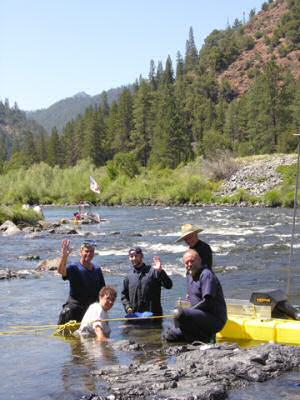
Four-inch sample team pauses to consider the next move,
as six-inch team is recovering gold just downriver.
K-11 also has some deeper, faster areas where potential for high-grade is really good. From past experience in this area, I felt pretty comfortable that if we hit the area hard with enough sampling, we would find some good gold deposits waiting for us.
As K-11 is such a long claim, We broke it down into three separate sampling areas: the top third of the claim; the center section; and the lower third of the claim. For practical purposes during these projects, I like to try and keep the several dredges we use within a reasonable distance of each other. Because once things really get going, I spend long days running up and down the bank, or swimming back and forth, going from dredge to dredge, while directing the sampling effort and coordinating the participants.
If we did not find what we were looking for in the upper section of the claim, my plan was to float all the gear down to the lower sections and continue the sampling effort there. I feel the potential for high-grade gold is just as good in the lower sections as it is in the top. As it was, we remained in the top section for the entire project, and several participants are still dredging high-grade in there as I write this newsletter.
Some members have been working good gold deposits on the far side of the river during earlier seasons. The problem is in transporting the people and gear from a Group Project over there from the road-side. There is a Forest Service road that goes around to the other side, but I did not want to lose the time driving all the way around every day. Another option was to use a boat at the USFS Rocky Point river access which is located about half-way down the claim. But we finally decided to start our project on the road-side. We needed to sample there anyway.
We spent the first day of the project doing orientation, moving several dredges with support gear down the hill, and getting all participants into the water for their first dives. We were using two 4-inch dredges to sample the slow, shallow areas nearer to the edge of the river. These dredges are set up for two divers each. While more experienced participants were getting a little sampling-work done further out in the river, I spent some quality time working with the less-experienced dredgers nearer to the shore.
From long experience at this, I find that beginners make very fast progress, even those who have a healthy fear of the water, as long as we begin their experience from a place where they are comfortable. Sometimes this means having the person hang out along the river’s edge for a while just looking underwater with a face mask. Once comfortable with that, I get the person looking from the edge using the mask, but breathing with the HOOKA regulator. Then I get the person to swim around the edge of the river on their own with mask and regulator, sticking his or her head down and getting used to the idea of breathing underwater. This usually progresses along just fine if the person is given some time on his or her own to work through the initial discomforts.
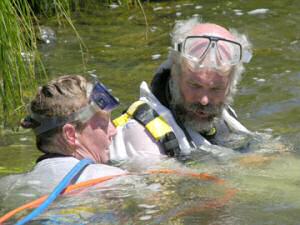 Herb Miller and Doti Buruursema prepare to start a sample hole on the far side of the river.
Herb Miller and Doti Buruursema prepare to start a sample hole on the far side of the river.
Before long, I am usually pressing down comfortably to hold the person just under the water’s surface while he or she is breathing through the regulator and looking around. It is a safe process, because I am right there being sensitive to how the person is doing. The key is to not push it too fast. The next step is to strap on the weights so the person can spend some time on the bottom in water shallow enough to get his or her head out of the water if he or she feels the need. From that point, it is seldom very long before the person is out helping on the designated beginner-dredge; the one that is operating in a very safe area.
One of my primary objectives in every project is to get all the less-experienced dredgers through these early stages and to the point where they feel comfortable working out in the river. All of the beginners in this project were competent dredgers by the time the project was over.
Years ago, I located a high-grade pay-streak out in the middle of the deeper, faster part of the river along the upper-portion of K-11. It was so long ago, I cannot even remember why we stopped dredging there, although I am sure it was not because the gold played out. The streambed is rather shallow out there; average maybe 2 feet to bedrock. The bedrock pays in the cracks and pockets when they are right. Sometimes the pay is very rich. So on the first day of the project, I directed Ernie Kroo and one of our more-experienced participants to do a sample right out in the middle, directly in line with where I had established high-grade gold in the past. They were operating a 6-inch dredge. And while they immediately started getting into some gold, it turned out that even our most experienced participant was not able to deal with the fast-water conditions out there.
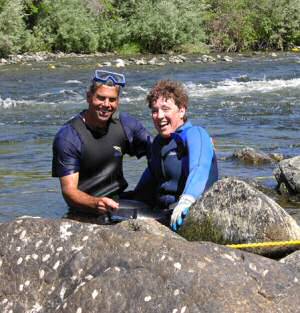 Sandy Crawford always ready to light up the day with a big smile.
Sandy Crawford always ready to light up the day with a big smile.
Meanwhile, Craig Colt and Dale Carnagy had drifted further downriver to do another sample in the middle using a 5-inch dredge. They were running into deep streambed material there. By the end of the second day, we decided to withdraw from the 5-inch sample hole in the middle of the river, because it was going to require a winch to be set up to move the boulders, the hole was going too deep to do on a 7-day project, and we knew there were other good gold prospects to sample on the far side of the river.
By the end of the second day, all participants, were out in the river pursuing the sampling effort using the two 4-inch dredges. Surprisingly, they located a pretty rich gold deposit in a hard-packed gray layer on the road-side of the river. We were already accumulating an interesting amount of gold from those two dredges. The excitement level was starting to build, and all participants wanted to spend more time in the water.
Because no-one was up to going out in the middle of the river with Ernie on the 6-inch dredge (where the rich pockets of gold are located), we decided to organize a production team to work with Ernie on the 6-inch dredge where the two 4-inch dredges had located a gold deposit closer to the edge of the river. On the third day, the two 4-inch dredges were moved further upriver on the road-side to continue the sampling process, while the 6-inch dredge was accumulating gold for the group project.
We also swung the 5-inch dredge across to the other side of the river to do a new sample. A long-time member from Sweden named Morgan had already been dredging on the other side for about a week, and he was
showing us a lot of beautiful gold, along with some nice nuggets that he was finding over there. The 5-inch dredge was put in line with Morgan several hundred feet downstream. Craig and Dale immediately got into some really nice gold over there, but there were big rocks that were going to require a winch. So they drifted back further downstream on the morning of the 4th day to begin another test hole.
While Ernie and his crew were in production with the 6-inch dredge, building up our accumulation of gold for the week, other crew members were performing sampling operations further upstream though the 4th day. They were finding gold up there in some shallow hard-pack, but it was not the high-grade deposits I was hoping to find. So we made a tactical decision to swing one 4-inch dredge across to the far side of the river to do some sampling upstream and in line with where Morgan was getting all his gold.
There is a system to getting a dredge safely across fast water. If you do it wrong, you are almost certain to dump the dredge over and lose a bunch of gear. If you do it right, it all happens so easily that everyone is left wondering what all the worry was about. That’s the way we always do it (the easy way!). So this was all good experience for those who had not seen it done before.
We asked for volunteers; and those who were the strongest swimmers were assigned to perform the samples on the other side of the river. There is also a proven-method for safely crossing a fast-moving river. Participants were getting a lot of exposure on this project in how to deal with more challenging conditions.
Once on the other side, participants used the 4-inch dredge to perform three good samples on the 5th day. Without any assistance from me, they discovered a rich gold deposit on their 3rd hole. I was so proud! This deposit is in the top layer of hard-pack. As the gold is fine in size, and they could not see it in the gravel, they did some small production-runs at different depths to discover where the gold was coming from. Right out of the text book! At the end of the day, the concentrates from their sluice box were so saturated with fine gold, that even I could not pan them out. The excitement-level was really building!
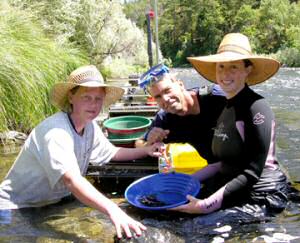
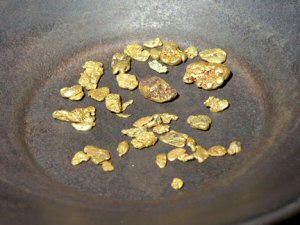
Enough nuggets were recovered that each participant got to choose 3 pieces as a part-share.
Further downstream, Craig and Dale located a rich gold deposit in about 4 feet of old original streambed on top of bedrock. They were getting lots of fine and flake-gold out of a gray layer, and also picking up some nuggets off the bedrock. Those guys were really excited!
The second 4-inch dredge was dropped down to spend most of the 5th day production-dredging along-side the 6-inch dredge. Between those 2 dredges, we were accumulating some nice gold. They were also getting some nuggets off the bedrock. Imagine; gold nuggets being recovered from both sides of the river! Interestingly, the 4-inch dredge was recovering more gold than the 6-inch dredge. We speculated this was because the gold line was stronger as they dredged closer to the edge of the river.
So we began the 6th day with 4 separate high-grade gold deposits being mined on the upper end of K-11. Morgan was mining one, and we had located three more. Because Craig and Dale had found so much gold the day before, we made the decision to swing the 6-inch dredge across and move it downriver to work alongside the 5-inch dredge. By now, we had been through this drill enough times that our crew probably could have done it without me around. But to be on the safe side, I always keep a personal hand in the most challenging exercises during any project. Getting the dredge across and set up in the new hole was done in very short order.
Because not everyone on the project was comfortable swimming the river, we launched a boat in the morning and used it to get people, gear and supplies over to the other side. All these logistics caused us to get somewhat of a late start under the water. We made up for that by working later. In fact, I was still trying to get everyone to shut down the dredges at 7 PM at the end of the 6th day. I wrote that off to gold fever. The deposits were pretty rich. Everyone was excited.
Managing these week-long projects is a personal challenge for me in many ways. Every project is entirely different, depending upon who the participants are, and where we choose to go on the river. I always balance the need to do things safely (primary concern), while providing participants exposure to the real thing; the way high-grade gold deposits are found and developed in the river. We always find some gold. But when the participants are the ones who discover high-grade, and pull themselves into a dedicated team-effort to recover as much gold as possible in the remaining time, I am certain the adventure-experience for them is something they will never forget. This is not television or a theme park. It is the real thing!
And I am personally rewarded with very meaningful experiences on every project. Watching a person struggle early in the week with deep-seated fears of the water and having to overcome them by reaching down inside to find the powerful substance of their most inner strength is a demonstration of true bravery. I get to be part of that each time we do a project. While I cannot put it into words, being alongside a person who is overcoming personal limits is a very meaningful and honorable experience. I feel very close to my crew members in this way.
Listening to the prospecting-chatter of participants at camp during the evening is a another special bonus to me; talking about the color and hardness of the different hard-packed streambed-material they had encountered during the day’s activities, and projecting hope for how those clues might lead us into the next pay-streak… This is a whole reality that is only understood by prospectors who have actually done it. Listening to the discussions and hope for the next discovery creates an inner reward for me, allowing me to believe that I am doing something meaningful by managing these Group Projects.
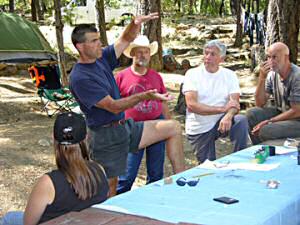
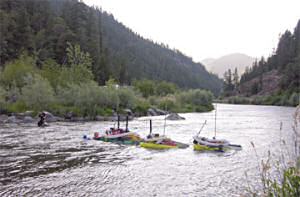
I suppose the highlight of this particular project for me was on the 7th day when we decided to connect 3 suction dredges together and float them down through a long stretch of fast water like a train. This equipment needed to be extracted off the river and stored away safely for the next project. The average person anywhere would be fully challenged to just float a single dredge downstream in fast water and across the Klamath River. But we hooked three of them up like a convoy of fully-loaded tractor-trailers! Everyone involved with this exercise did their part like we had been working years together as a mining-team.
Naturally, I took the most upstream position on the rope to guide the chain of dredges, so I could keep a close eye on the whole operation. And I cannot remember ever feeling so proud, watching the teamwork and listening to the enthusiastic coordination of my partners in this adventure. For me, this feeling always seems to go along with the sad realization that the team will soon break up, with most everyone needing to go back to their normal lives.
We spent the 7th day pulling the dredging gear out of the river and cleaning all the concentrates we accumulated for the week. Doing a final clean-up is too time consuming to do every day on one of these projects. So we save it all up for the last day. Cleaning up a substantial accumulation of concentrates that contain a lot of fine gold, and accomplishing a full separation so that the gold can be split off evenly amongst the participants, is a fair amount of work. 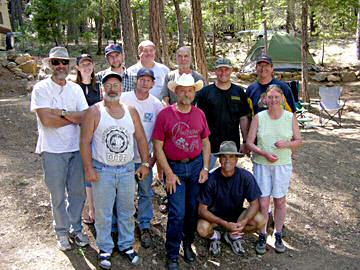 We never use mercury or any chemicals in the process. It is important for every prospector to know how to do the final gold separation. On our projects, under my careful guidance, the participants do almost all of the work. But I always get the personal pleasure of weighing out all the final shares.
We never use mercury or any chemicals in the process. It is important for every prospector to know how to do the final gold separation. On our projects, under my careful guidance, the participants do almost all of the work. But I always get the personal pleasure of weighing out all the final shares.
In all, we recovered nearly 3 ounces of gold for the week, of which 11.8 pennyweights (a little more than half-ounce) were nuggets. Two pretty important pay-streaks were located; both which are being worked by numerous members as I write this newsletter. The richest part of the upper claim remains relatively untapped, because it lies under a section of deeper, faster water which we could not access using the team involved with this project.





